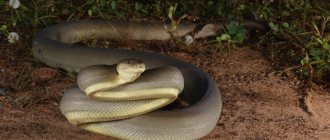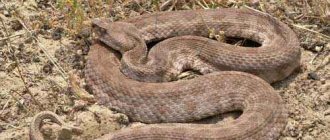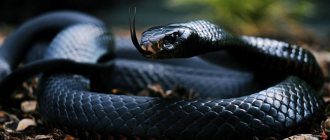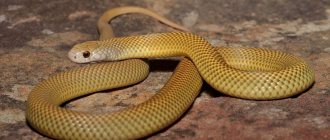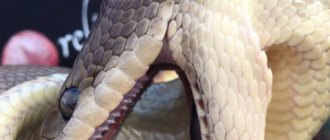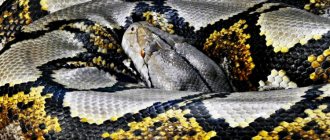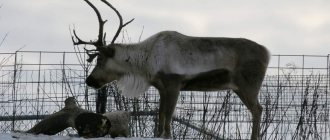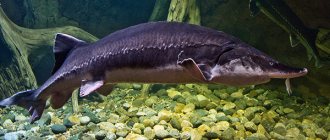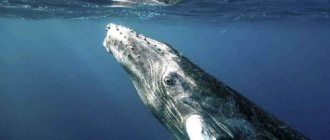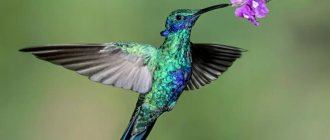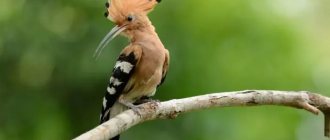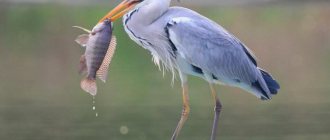- Wild animals
- >>
- Reptiles
The reticulated python is a non-venomous snake and the longest in the world. In some countries of its range it is hunted for its skin, used for traditional medicine and for sale as a pet. It is one of the three heaviest and longest snakes in the world. Large individuals can reach 10 m in length. But more often you can find a reticulated python 4-8 m long. The record specimen that lived in the zoo reached 12.2 m. If you want to know more, check out this article.
Reticulated python
It is one of the largest snakes living on our planet. Their habitat extends mainly to south and southeast Asia. Swedish researcher Ralf Blomberg managed to describe in his works “Giant Snakes and Strange Lizards” a specimen whose length almost reached 10 meters.
In New York's Bronx Zoo, there once lived a female specimen named Samantha, whose length reached 7 and a half meters. While in captivity, she delighted zoo visitors for a long time, but died in 2002.
When in the natural environment, reticulated pythons grow to more than 8 meters due to the diversity of their diet, which includes various vertebrates, including monkeys, small ungulates, rodents, reptiles, etc.
Interesting moment! The python often eats bats. To do this, the snake catches them in flight, clinging with its tail to the protruding parts of stone caves.
Pythons do not mind feasting on ungainly pets such as dogs, goats, birds, pigs and others. The most sought after pythons are young individuals weighing no more than 15 kg, although according to some statements the python swallowed pigs whose weight reached 60 kg.
History of the origin of the species
The reticulated python (Python reticulatus) is one of the largest representatives of the Pseudopod family.
This is an ancient group of snakes. The oldest remains of an ancestor are about 47 million years old. Representatives of the family retain rudiments. In particular, the rudiments of the hind limb belt. In many species, claws are clearly visible. Scientists still do not understand many stages of the formation of this family. And now fossil remains of intermediate evolutionary variants are being discovered.
Appearance of a reticulated python
“The geographical origin of pythons is still unclear. The discovery of a new species of python at Messel Quarry is a major step forward in understanding the evolutionary history of these snakes."
Professor Christer Smith at the Senckenberg Research Institute in Germany
Anaconda
This snake is a member of the boa constrictor subfamily and has several names. It is called the common anaconda, giant anaconda or green anaconda, although it is generally called, as in the past, the water boa, since the snake prefers to live in water. The main habitat of the anaconda extends to the basins of the Orinaco and Amazon rivers, while the snake chooses areas where the current is weak or non-existent.
The size of the anaconda is no less impressive. Evidence of this is the fact that a snake more than 5 meters long (without a tail) that weighed 97 and a half kilograms was caught in Venezuela. It was a female specimen. As for males, they are not so impressive in size, and they are also weaker than females.
An amazing fact is that fish is not the main dish for the anaconda, despite the fact that it lives in water and rarely appears on land. As a rule, this boa constrictor prefers to hunt waterfowl, caimans, capybaras, iguanas, agoutis and other mammals and reptiles no larger than medium size. This snake's diet includes lizards, turtles, and other types of snakes. It is known that the water boa hunts pythons if their length is no more than 2 and a half meters.
7 BIGGEST SNAKES CAUGHT ON CAMERA
Links[edit]
- ^ a b Stewart, B.; Thy, N.; Chan-Ard, T.; Nguyen, T.Q.; Grismer, L.; Aulia, M.; Das, I., and Vaughan, G. (2018). "Python reticulum". IUCN Red List of Threatened Species
.
2018
: e.T183151A1730027. - ^ abc MacDiarmid, R.W.; Campbell, J.A.; Toure, T. A. (1999). Snake Species of the World: A Taxonomic and Geographical Guide, Volume 1
. Washington: League of Herpetologists. ISBN 9781893777002. - ^ a b Hoser, R. (2003). "Reclassification of Pythoninae, including descriptions of two new genera, two new species and nine new subspecies. Part I". Crocodilian is the magazine of the Victorian Association of Amateur Herpetologists
.
4
(3): 31–37. - https://www.smuggled.com/issue-16-19-26.pdf
- Species of Malayopython reticulatus
in the reptile database www.reptile-database.org. - Selk, Avi. “A woman went to check her corn and a python swallowed it.” Washington Post
. Retrieved June 17, 2022. - ^ab Shawn Rossman (March 30, 2022). “Pythons can kill a person in minutes and swallow them in an hour.” USA Today
. - Coulouris, Christopher. “Photos: Indonesian man Akbar Salubiro found eaten alive by python. - Scallywag and Vagabond." scallywagandvagabond.com
. Retrieved May 28, 2022. - Jump up
↑ Schneider, J. G. (1801).
"Reticulata". Historiae Amphibiorum naturalis et literariae Fasciculus Secundus continens Crocodilos, Scincos, Chamaesauras, Boas, Pseudoboas, Elapes, Angues, Amphisbaenas et Caecilias
(in Latin). Jenae: Wesselhoeft. pp. 264–266. - Goch, A. F. (1986). Reptiles - explanation of their Latin names
. Poole, UK: Blandford Press. ISBN 0-7137-1704-1. - Daudin, F. M. (1803). "Python". Histoire naturelle, générale et specialulière, des reptiles. Volume 8
. Paris: De l'Imprimerie de F. Dufart. paragraph 384. (In French). - Jump up
↑ Kluge, A.G. (1993).
"Aspidis and the phylogeny of python snakes". Records of the Australian Museum
(Appendix 19): 1–77. - Lawson, R.; Slowinski, J.B.; Burbrink, F. T. (2004). "A molecular approach to elucidating
the phylogenetic position of the cryptic snake
Xenophidion schaeferi
within Alethinophidia".
Journal of Zoology
.
263
(3):285–294. DOI: 10.1017/S0952836904005278. - ^ a b Hoser, R. (2004). "Reclassification of Pythoninae, including descriptions of two new genera, two new species and nine new subspecies. Part II". Crocodilian is the magazine of the Victorian Association of Amateur Herpetologists
.
4
(4): 21–40. - Rawlings, L.H.; Rabosky, D. L.; Donnellan, South Carolina; Hutchinson, Minnesota (2008). "Phythogenetics of the Python: Inference from Morphology and Mitochondrial DNA" (PDF). Biological Journal of the Linnean Society
.
93
(3):603–619. DOI: 10.1111/j.1095-8312.2007.00904.x. - Kaiser, H.; Crother, B.I.; Kelly, C.M.R.; Luiselli, L.; O'Shea, M.; Ota, H.; Passos, P.; Schleip, W.; Wüster, W. (2013). "Best Practices: In the 21st Century, taxonomic decisions in herpetology are only acceptable if they are supported by a body of evidence and published through peer review" (PDF). Herpetological Review
.
44
(1): 8–23. - Reynolds RG, Niemiller ML, Revell LJ (2014). "Toward a tree of life for boas and pythons: a multilocal species-level phylogeny with unprecedented taxon sampling." Molecular phylogenetics and evolution
.
71
: 201–213. DOI: 10.1016/j.ympev.2013.11.011. PMID 24315866. - https://www.smuggled.com/issue-25-pages-14-38.pdf
- "Python reticulum". Integrated Taxonomic Information System. Retrieved September 12, 2007.
- Jump up
↑ Barker DG, Barker TM, David MA, Schuett GW (2015).
"Review of the systematics and taxonomy of Pythonidae: an ancient serpentine lineage" (PDF). Zoological Journal of the Linnean Society
.
175
: 1–19. DOI: 10.1111/zoj.12267. - Booth W, Schuett GW (2016). "An emerging phylogenetic pattern of parthenogenesis in snakes". Biological Journal of the Linnean Society
.
118
(2):172–186. DOI: 10.1111/bij.12744. - ^ a b Mattison, K. (1999). Snake
. London: Dorling Kindersley Publishers. ISBN 978-0-7894-4660-2. - ^ B s d e Auliya, M.; Mausfeld, P.; Schmitz, A.; Böhme, W. (April 9, 2002). "Review of the reticulated python ( Python reticulatus
Schneider, 1801) with a description of a new subspecies from Indonesia."
Naturwissenschaften
.
89
(5):201–213. Bibcode: 2002NW…..89..201A. DOI: 10.1007/s00114-002-0320-4. PMID 12135085. S2CID 4368895. - Jump up
↑ Boulenger, G. A. (1893).
"Python reticulum". Catalog of Snakes in the British Museum (Natural History)
. Volume I, Containing the Families of ... Boidæ ... London: Trustees of the British Museum (Natural History). pp. 85–86. - ^ ab Shine R., Harlow P. S., Keogh J. S., Boedi N. I. (1998). "Effects of sex and body size on the feeding habits of the giant tropical snake Python reticulatus". Functional Ecology
.
12
(2): 248–258. DOI: 10.1046/j.1365-2435.1998.00179.x. S2CID 46957156. - Wood, G. (1983). Guinness Book of Records and Animal Feats
. ISBN 978-0-85112-235-9. - ^ a b Fredriksson, G. M. (2005). "Predation on sun bears by reticulated pythons in East Kalimantan, Indonesian Borneo" (PDF). Raffles Zoological Bulletin
.
53
(1): 165–168. Archived from the original (PDF) on August 11, 2007. - ^ abc Barker, David J.; Barten, Stephen L.; Ehrsam, Jonas P.; Daddono, Louis (2012). "Adjusted lengths of two well-known giant pythons and setting a new maximum length record for Burmese pythons, Python bivittatus" (PDF). Bull. Chicago Herp. Soc
.
47
(1): 1–6. - ^ abcde e Murphy, John K.; Henderson, Robert W. (1997). Tales of Giant Snakes: A Historical Natural History of Anacondas and Pythons
. Krieger Publishing Co., pp. 24–26, 35, 47–50, 55–56. ISBN 978-0-89464-995-0. - ^ ab Mehrtens JM (1987). Living snakes of the world in color
. New York: Sterling Publishing. 480 pp. ISBN 0-8069-6460-X. - "Columbus Zoo Pays to Keep Largest Snake in Captivity Permanently". Fox News
. January 14, 2008 - Aglionby, John (2004-01-05) "Stay where you are, okay?" . The keeper
. Retrieved August 21, 2012. - “The longest snake in the world is not suitable.” China Daily.
- "Longest Snake - Ever (captivity)". Guinness Book of Records
. 2011. Retrieved February 4, 2016. - "Python Care Mesh Sheet". www.reptilesmagazine.com
. Retrieved July 7, 2022. - ^ a b Stidworthy J (1974). Snakes of the world
. Grosset & Dunlap Inc., 160 pp. ISBN 0-448-11856-4. - ^ab Cape, Tennessee; Green, H. W. (2011). "Hunter-gatherers and other primates as prey, predators, and competitors of snakes". Proceedings of the National Academy of Sciences
.
108
(52): E1470–E1474. DOI: 10.1073/pnas.1115116108. PMC 3248510. PMID 22160702. - Kopstein, F. (1927). " Over het verslinden van menschen door
Python reticulatus" [On the human ingestion
of P. reticulatus
].
Nature Trails
(4): 65–67. (in Dutch) - Bruno, S. (1998). "I serpenti giganti" [giant snakes]. Criptozoologia
(in Italian).
4
: 16–29. Archived from the original on 2007-02-28. - Kobis I (1995). "Giant python killed after attempting to swallow man". The Star (Malaysian English newspaper), 16 September 1995
- "Woman killed by pet 13ft python". UPI. 2008. Retrieved October 27, 2008.
- "In Las Vegas, a python faces off against an angry mom with a knife". Las Vegas, sunshine. 2009. Retrieved January 23, 2009.
- "Python kills security guard outside luxury hotel in Bali" in The Jakarta Post. Accessed June 29, 2022
- Nurhadi (2017). » Beginilah Ular Piton Menelan Akbar Petani Savit Memuju Tengah » . Tribune Timur
(in Indonesian). Retrieved March 28, 2022. - "Missing man found dead in belly of seven-metre python in Indonesia: report". Straits Times
. 2022. Retrieved March 29, 2022. - "Indonesian man's body found inside python - police". BBC
. 2022. Retrieved March 29, 2022. - "23-foot python swallows Indonesian woman near her garden". Los Angeles Times
. Retrieved June 17, 2022. - "Seorang Pelajar SMP Dililit Ular Piton hingga Tewas" (in Indonesian). Compass. June 15, 2022. Retrieved June 15, 2020.
- "Reticulated Python (Python reticulatus) - Eco Terrarium Supply". Archived from the original on 2008-12-30. Retrieved February 6, 2009.
- "Reticulated Pythons - Boatips.com". Retrieved February 6, 2009.
King Cobra
The name cobra means “snake eater”. In fact, this is true, since the cobra preys on other types of snakes, including poisonous ones. The king cobra has another name - hamadryad. They live up to 30 years and do not stop growing throughout their lives. The tropics are simply teeming with these poisonous creatures, extending to countries such as India, Indonesia, Pakistan and the Philippines.
In 1937, the largest specimen was caught in Malaysia, after which the snake was transported to the London Zoo. When she was measured, it turned out that her length was 5 meters 71 centimeters, which was officially recorded. According to eyewitnesses, longer individuals are also found in the natural environment, with values from 3 to 4 meters taken as the average size.
The very name of cobra fills many with real fear. In fact, this snake is not considered the most poisonous and, moreover, it rarely attacks first. If a person with his own eyes is at the level of the cobra’s eyes and holds its gaze, then the cobra, without showing aggression, will calmly leave, unexpectedly meeting the person.
Hieroglyphic python
It is a fairly large snake, weighing almost 100 kg, with a length of more than 6 meters. Individuals of this size are very rare, so the hieroglyphic python rarely grows to 5 meters in length and weighs no more than 60 kilograms.
Interesting to know! The python's body is not only massive, but also slender, which allows the snake to easily climb trees at night and also feel great in the water.
The habitat of hieroglyphic (rock) pythons extends to savannas, as well as the tropics and subtropics of the African continent.
Like many species of snakes, this python can go without food for a long time. When in captivity, it can live at least a quarter of a century. The python is not poisonous, but behaves very aggressively and can be dangerous to humans. In 2002, a ten-year-old boy was swallowed by a snake in South Africa.
These reptiles can easily attack leopards, Nile crocodiles, warthogs, as well as black-footed antelopes, while the main diet consists of rodents, birds and reptiles.
Features of character and lifestyle
Photo: Reticulated Python
Despite their proximity to humans, little is known about the behavior of these animals. The reticulated python is nocturnal and spends most of the day in hiding. The distances animals travel during their lives, or whether they have fixed territories, have not been thoroughly studied. The reticulated python is a solitary animal that only interacts during mating season.
These snakes occupy areas with water sources. During movement, they are able to contract muscles and simultaneously release them, creating a snake-like pattern of movement. Due to the linear movement and large body size of reticulated pythons, the type of movement of the snake in which it compresses its body and then unfolds in a linear motion is observed more often as it allows larger individuals to move faster. Using a squeezing and straightening technique, the python can climb trees.
Interesting Fact: Using similar body movements, reticulated pythons, like all snakes, shed their skin to repair wounds or simply during life stages of development. Shedding of skin, or peeling, is necessary to facilitate the ever-growing body.
The reticulated python hears virtually no noise and is visually limited due to its fixed eyelids. Therefore, it relies on its sense of smell and touch to find prey and avoid predators. The snake does not have ears; instead, it has a special organ that allows it to sense vibrations in the ground. Because they lack ears, snakes and other pythons must use physical movements to create vibrations through which they communicate with each other.
Dark tiger python
Females of this species of snakes are very impressive in size compared to males, growing on average up to 3.7 meters, while the length of individual individuals can reach at least 5 meters.
The tiger python's habitat extends to countries such as India, Vietnam, Thailand, Malaysia, Myanmar, Nepal, Cambodia, southern China and the island. Hainan and also Indochina. The dark tiger python, thanks to man, appeared in Florida, in the United States.
The dark python, living in the American Snake Safari Park in Illinois, had a body length of 5.74 meters.
The python's diet consists of birds and mammals, in the form of monkeys, jackals, pigeons, waterfowl, various lizards, crested porcupines, and various rodents. In addition, the reptile, on occasion, can swallow various domestic animals and birds.
Gallery
- Python reticulatus reticulated python-1.jpg
- Reticulated Python 01 brighter.jpg
- Reticulated Python 04.jpg
Reticulated python swallows chicken
- Reticulated python MP1.JPG
- Reticulated python albino head MN 2007.JPG
Albino reticulated python
- Juvenile tiger retic.jpg
Juvenile reticulated python (captive-bred "tiger" morph)
Light tiger python
It belongs to the subspecies of the tiger python and is also called the Indian python. It is a close relative of the dark tiger python, but is slightly smaller in size. These reptiles do not grow more than 5 meters. The light tiger python can be distinguished from other large snakes by a number of characteristics:
- The sides of the body are decorated with spots, with light splashes in the center.
- There are either pinkish or reddish stripes on the side of the head.
- A diamond-shaped pattern is visible, albeit blurred, at the front of the head.
- Compared to the darker subspecies, lighter tones predominate, made in brown, yellow-brown, red-brown and gray-brown shades.
This reptile lives in the forests of India, Pakistan, Bhutan, Nepal and Bangladesh.
Further reading[edit]
- Aulia M.A. (2003). Taxonomy, life history and conservation of giant reptiles in West Kalimantan
. PhD. doctoral dissertation, University of Bonn. - Aulia, Massachusetts; Mausfeld, P; Schmitz, A; Böhme, W. (2002). "Review of the reticulated python ( Python reticulatus
Schneider, 1801 [
sic
]) with a description of a new subspecies from Indonesia."
Naturwissenschaften
.
89
(5):201–213. Bibcode: 2002NW…..89..201A. DOI: 10.1007/s00114-002-0320-4. PMID 12135085. S2CID 4368895. (HTML abstract, electronic supplement available for subscribers). - Raven, H. C. (1946). "Adventures in the land of pythons." Natural History
.
55
: 38–41. - Gloss, R; Ambariyanto, Harlow PS; Mumpuni (1999). "Reticulated pythons in Sumatra: biology, harvest and sustainability". Biol.
Canned .
87
(3):349–357. DOI: 10.1016/s0006-3207 (98) 00068-8.
Amethyst Python
This is the largest snake living on the Australian continent. Currently protected by Australian law. The length of adult individuals can reach 8 and a half meters, with a weight of at least 30 kilograms.
Average sizes, as a rule, do not go beyond 3 and a half meters. It differs from various types of pythons by the presence of large, symmetrically located scutes on the top of the head.
Experts determine that this is an amethyst python based on the following characteristics:
- The main body color is olive-brown or olive-yellow, with a peculiar iridescent tint.
- Black and brown contrasting stripes run across the body.
- Closer to the back, a grid-like pattern formed by dark and light stripes clearly stands out.
The amethyst python's diet includes small birds, lizards and small mammals. Often their victims are bush kangaroos and marsupial cuscus.
Important point! Indigenous people (aboriginals) claim that these reptiles attack domestic animals because they can identify their prey from afar by the heat emanating from it.
To ensure that domestic animals and living creatures do not serve as a source of food for the python, they are kept in special enclosures. In this regard, in Australia, parrots, rabbits, cats, dogs, and other animals are kept in cages.
Notes
- Ananyeva N. B., Borkin L. Ya., Darevsky I. S., Orlov N. L.
Five-language dictionary of animal names. Amphibians and reptiles. Latin, Russian, English, German, French. / under the general editorship of academician. V. E. Sokolova. - M.: Rus. lang., 1988. - P. 276. - 10,500 copies. — ISBN 5-200-00232-X. - [www.itis.gov/servlet/SingleRpt/SingleRpt?search_topic=TSN&search_value=209567 ITIS Standard Report Page: Python reticulatus]. www.itis.gov. Retrieved May 8, 2016.
- [sivatherium.narod.ru/library/Blomberg/book.htm Blomberg R. Giant snakes and terrible lizards]
- Shine, R., Harlow, P. S., & Keogh, J. S. (1998). The influence of sex and body size on food habits of a giant tropical snake, Python reticulatus
. Functional Ecology, 12(2), 248–258. - [www.eastnusatenggaratours.com/3-istana-ular-reptilian-adventure-west-flores-reptilian-tours-nusatenggara-.html Tours Travel agent, trip to Komodo Rinca island Tours dives, Flores Overland Tours, sumba Timor Land Tours, Komodo national park,komodo boat trip,]. www.eastnusatenggaratours.com. Retrieved May 8, 2016.
- ↑ 1 2
Fredriksson, G. M. (2005).
"[dare.uva.nl/document/2/39161 Predation on Sun Bears by Reticulated Python in East Kalimantan, Indonesian Borneo]". Raffles Bulletin of Zoology 53
(1): 165–168. - [www.chinadaily.com.cn/en/doc/2004-01/08/content_296803.htm World's 'longest snake' comes up short]
- [www.academia.edu/4075899/Selvaraj_2013_Tomistoma Selvaraj 2013 Tomistoma]. www.academia.edu. Retrieved December 28, 2015.
- [eagah.blogspot.ru/2015/10/sight-of-croc-eating-python-shows-alles.html SOLYMONE BLOG: SIGHT OF CROC EATING PYTHON SHOWS ALL'ES WELL IN RIVER OF SABAH, BORNEO]. egagah.blogspot.ru. Retrieved December 28, 2015.
- [www.amazon.com/The-Behavioral-Ecology-Komodo-Monitor/dp/081300621X The Behavioral Ecology of the Komodo Monitor]. — Gainesville: University Press of Florida, 1981-11-01. — 406 p. — ISBN 9780813006215.
- [it.sohu.com/20071015/n252651496.shtml 爬行动物之争科莫多巨蜥捕食花纹蟒蛇全程(图)-搜狐IT]. it.sohu.com. Retrieved December 28, 2015.
- [www.researchgate.net/publication/259932038_Giant_constrictors_Biological_and_management_profiles_and_an_establishment_risk_assessment_for_nine_large_species_of_pythons_anacondas_and_the_boa_constrictor Giant constrictors: Biological and management profiles and an establishment risk assessment for nine large species of pythons, anacondas, and the boa con strictor.]. ResearchGate. Retrieved December 28, 2015.
- [www.zoo.nikolaev.ua/news.php Nikolaev Zoological Garden]
Common boa constrictor
Currently, 10 subspecies are known, which differ from each other in both habitat and body color. As a rule, due to their special color, boas are easily camouflaged in the natural environment. This is especially important for them, since they lead an isolated lifestyle.
In the natural environment, ordinary boas grow up to 5 and a half meters in length, gaining weight up to 25 kilograms. If kept in captivity, they do not grow more than 3 meters. The common boa constrictor is found throughout Central and South America, as well as in the Lesser Antilles. For their life activities, these reptiles choose dry areas, but not far from various bodies of water.
The diet of the boa constrictor is no different, since it consists of birds, small mammals, and reptiles. The boa constrictor kills its victim in a special way, squeezing the chest. In other words, it simply suffocates living beings.
Interesting to know! Boas easily adapt to life in captivity, so they can be easily seen in zoos around the world, as well as in home terrariums. The bite of a boa constrictor is not poisonous.
Danger to people[edit]
Large reticulated pythons are sometimes found on the outskirts of Bangkok. It usually takes at least two people to successfully remove a snake this large.
Reticulated Python in Pune
The reticulated python is one of the few snakes that preys on people. Attacks on humans are not common, but the species has been responsible for several reports of human casualties both in the wild and in captivity. Given the known maximum prey size, an adult reticulated python can open its jaws wide enough to swallow a human, but the shoulder width of some adult Homo sapiens
can be a problem even for a snake of sufficient size. Reports of human casualties and human consumption (the latest well-confirmed examples of adult consumption) include:
- Early 20th century Indonesia: On the island of Salibabu, North Sulawesi, a 14-year-old boy was killed and allegedly eaten by a 5.17 m (17.0 ft) specimen. Another incident involved a woman who was reputedly eaten by a "large reticulated python", but few details are known. [38]
- In the early 1910s or 1927, the jeweler went hunting with his friends and was apparently eaten by a 20-foot python after taking shelter from a rainstorm in or under a tree. Presumably he was swallowed feet first, but this may be the easiest way for a snake to swallow a human. [39]
- In 1932, Frank Buck wrote about a teenage boy who was eaten by a 7.6 m long pet reticulated python in the Philippines. The python escaped, and when it was found, the snake was found to contain a human child, who turned out to be the son of the snake's owner, Buck said. [40]
- Among a small group of Aeta negritos in the Philippines, six python deaths were reported over a 40-year period, plus one died later from an infected bite. [37]
- In September 1995, a 29-year-old rubber from the southern Malaysian state of Johor was reported to have been killed by a large reticulated python. The victim was apparently taken by surprise and pinched to death. The snake coiled itself around the lifeless body, grabbing the victim's head in its mouth when the victim's brother came upon it. The python, which stood 23 feet (7.0 m) tall and weighed more than 300 pounds, was soon killed by arriving police, who shot it four times. [29]
- In October 2008, a 25-year-old woman was killed by a 13-foot (4.0 m) reticulated python. The apparent cause of death was asphyxiation. The snake was later found in the bedroom in an agitated state. [41]
- In January 2009, a three-year-old boy was wrapped in the coils of an 18-foot (5.5 m) reticulated python, which turned blue. The boy's mother, who was petting the python on behalf of a friend, saved the baby by stabbing the python with a knife. The snake was later euthanized due to its wounds. [42]
- In December 2013, a 59-year-old security guard was strangled to death while trying to catch a python outside the Bali Hyatt, a luxury hotel on an Indonesian resort island. The incident occurred around 3 am when the 4.5-meter python was crossing the road near the hotel. The victim offered to help catch the snake, which had previously been seen several times near a hotel in the Sanur area of Bali and had retreated back into the nearby bushes. [43]
- In March 2022, the body of Akbar Salubiro, a 25-year-old farmer from Central Mamuju Regency, West Sulawesi, Indonesia, was found inside the stomach of a 7 m (23 ft) reticulated python. He was reported missing from his palm plantation, and people searching for him found the python the next day with a large bulge in its stomach. They killed the python and found the missing farmer's entire body inside. This was the first fully confirmed case of a person being eaten by a python. The process of removing the body from the python's stomach was documented with photographs and videos taken by eyewitnesses. [44] [45] [46]
- In June 2022, a 54-year-old Indonesian woman on Muna Island, southeast Sulawesi, Indonesia was killed and eaten by a 23-foot python. A woman went missing one night while working in her garden and a search party was organized the next day after some of her belongings were found abandoned in the garden. The python was found near the garden with a large bulge on its body. The snake was killed and taken to the city, where it was cut open, revealing the woman's completely intact body. [47] Video of the disemboweled snake was posted online. [7]
- In June 2022, a 16-year-old Indonesian boy was killed by a 7 m (23 ft) long python in Bombana Regency, southeast Sulawesi, Indonesia. The incident took place near a waterfall on Mount Kahar in Rumbia sub-district. The victim was separated from four friends in the woods. When he screamed, his friends came to his aid and discovered that he had been coded by a large python. The villagers came to the rescue and managed to kill the snake using a parang machete. However, the victim had already suffocated. [48]
Bushmaster
This snake is also called surukuku and is the largest venomous snake from the viper family that lives within South America. Its lifespan reaches about 20 years.
Adults can grow to almost 4 meters, although most specimens are found that are no more than 3 meters long and weigh no more than 5 kilograms. This poisonous snake has poisonous fangs that grow up to 4 cm in length.
Bushmaster prefers to lead an isolated lifestyle, so it is very rare. The habitat is associated with the island of Trinidad, as well as with the tropics of South and Central America.
It is important to know! This snake poses a great danger to humans, although the mortality rate from its bites is only 12 percent.
The peak of activity occurs at night. The snake hunts its victims by lying motionless on the ground, among leaves or grass. The surukuku can remain motionless for weeks, waiting for either a lizard, a bird, a rodent, etc.
Classification
The species forms three subspecies:
- Broghammerus reticulatus reticulatus
- The nominative subspecies, which is the largest and most widespread. Around the middle of the body there are 68-78 scales, ventral scutes 304-325. The range of this subspecies covers Bangladesh, Myanmar, Thailand, Nicobar Islands, Cambodia, Laos, Vietnam, Malaysia, Singapore, Brunei, Indonesia (Anambas, Sumatra, Simelue, Nias Islands, Batu Islands, Mentawai Islands, Engano, Banka, Belitung, Kalimantan , Bunguran Islands (Natuna), Krakatoa, Java, Bali, Lombok, Sumbawa, Sumba, Flores, Timor, Bobar Islands, Tanimbar Islands, Sulawesi, Butung, Sula Islands, Buru, Ambon, Seram, Obi Islands, Halmahera, Ternate, etc. .), Philippines. Absent from New Guinea. - Broghammerus reticulatus saputrai
- Around the middle of the body there are 77-81 scales, ventral scutes 330-334. It lives in Indonesia in the southwest of Sulawesi and Salayar Island. - Broghammerus reticulatus jampeanus
is a dwarf island subspecies, with adults reaching 2–2.5 m in length. Around the middle of the body there are 64-68 scales, ventral scutes 290-301. Differs in dull color. Lives on the island of Tanahjampea, Indonesia.
Black Mamba
This poisonous snake is found on the African continent, choosing open forests and savannas for its life. Almost all the time it is on the ground, but occasionally it can be seen on trees, where they bask in the sun.
The average statistical indicators correspond to a body length of no more than 3 meters, with a mass of about 2 kilograms, although there are individuals weighing 3 kilograms, with a body length of more than 4 meters.
The black mamba has the longest poisonous teeth, reaching 2 and a half centimeters in length, when compared with its relatives, representing the asp family.
The diet consists of bats, elephant leapers, hyraxes, rodents, birds, as well as other types of snakes.
Interesting fact! Compared to some other snake species, the black mamba prefers to hunt during the daytime. She injects poison into her victim and then swallows it. Food is digested within a day, or even more.
General information about snakes
You may be interested in:Spanish lynx: features of the species
It should be noted that human fears regarding snakes are greatly exaggerated. After studying their behavior, we can conclude that the likelihood of dying in road traffic and other accidents is much higher than from the bite of a poisonous snake. Of course, among such reptiles there are representatives that evoke fear and horror, although they are not poisonous. This is especially true for the largest individuals.
What is the largest snake on Earth? The longest and largest snake is the reticulated Asian python. In the natural environment, it reaches unimaginable sizes, weighing 1.5 centners.
Shedding
Periodically, the python changes its skin. The approach of molting is signaled by paleness of the color - this means that in about a day and a half the snake will begin to molt. She copes with this perfectly on her own, however, if problems arise, bathing in warm water with the addition of oil (for example, special baby oil) can help the process. You can help by gently removing the skin with your palms (pay special attention to the eyes and tail).
Reproduction
Photo: Embora Pets
Pythons are oviparous, not viviparous animals. The females of most, if not all, species wrap themselves around the eggs, and some even carry them to term. Females select thermally stable nesting sites, then lay eggs and coil themselves around them so that the eggs are in contact only with the mother's body. When the air temperature begins to drop, the female produces heat by shivering through a series of tiny muscle contractions, and thus maintains an elevated and fairly constant incubation temperature.
Number of eggs laid : from 2 to 100, depending on the species
Incubation period : 40 to 100 days, depending on the species
Hatching length : from 25 to 70 centimeters
Age of maturity : 2 to 8 years
Photo: San Diego Zoo
